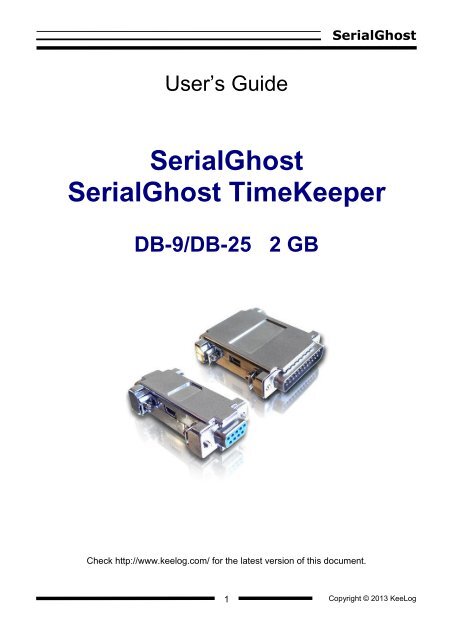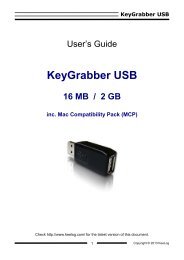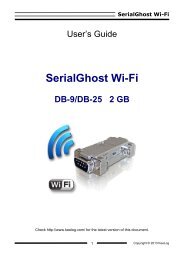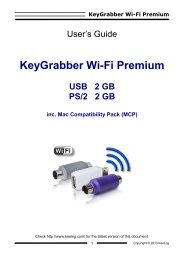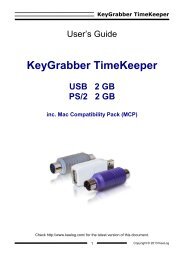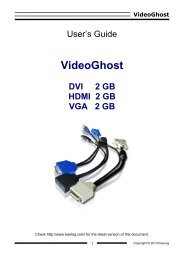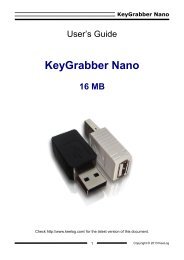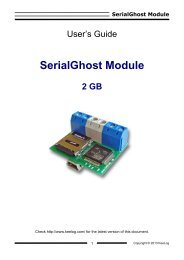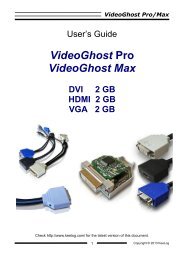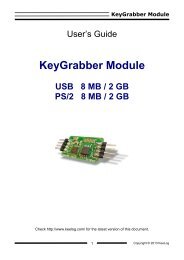Serial RS-232 Logger User Guide - SerialGhost
Serial RS-232 Logger User Guide - SerialGhost
Serial RS-232 Logger User Guide - SerialGhost
Create successful ePaper yourself
Turn your PDF publications into a flip-book with our unique Google optimized e-Paper software.
<strong>Serial</strong>Ghost<br />
<strong>User</strong>’s <strong>Guide</strong><br />
<strong>Serial</strong>Ghost<br />
<strong>Serial</strong>Ghost TimeKeeper<br />
DB-9/DB-25 2 GB<br />
Check http://www.keelog.com/ for the latest version of this document.<br />
1<br />
Copyright © 2013 KeeLog
<strong>Serial</strong>Ghost<br />
Table of contents<br />
Getting started ................................................................................................................. 2<br />
Introduction ...................................................................................................................... 3<br />
About the product ......................................................................................................... 3<br />
Features ....................................................................................................................... 3<br />
Requirements ............................................................................................................... 3<br />
Quick Start ....................................................................................................................... 4<br />
Configuration ................................................................................................................... 7<br />
Recording data................................................................................................................. 9<br />
Viewing recorded data .................................................................................................... 10<br />
Clock configuration (TimeKeeper version only) ................................................................. 12<br />
Configuration files .......................................................................................................... 14<br />
CONFIG.TXT .............................................................................................................. 14<br />
TIME.TXT ................................................................................................................... 15<br />
Using KL Tools............................................................................................................... 16<br />
Specifications ................................................................................................................. 17<br />
Troubleshooting ............................................................................................................. 18<br />
Legal disclaimer ............................................................................................................. 20<br />
Getting started<br />
Already familiar with <strong>Serial</strong>Ghost data loggers?<br />
Configure your device and start logging in 5 simple steps: section Quick Start<br />
New to <strong>Serial</strong>Ghost data loggers?<br />
First, configure the serial bus parameters: section Configuration<br />
Then learn about recording data: section Recording data<br />
Finally, retrieve the recorded data: section Viewing recorded data<br />
Questions or problems?<br />
Go through the Troubleshooting section.<br />
2<br />
Copyright © 2013 KeeLog
<strong>Serial</strong>Ghost<br />
Introduction<br />
About the product<br />
The <strong>Serial</strong>Ghost is a compact <strong>RS</strong>-<strong>232</strong> and serial bus logger with a memory capacity of 2GB,<br />
that may be accessed as a USB Flash drive. Bidirectional data flowing through the serial bus<br />
will be captured and stored on the internal Flash Drive in a special file. This data may be<br />
retrieved by switching to Flash Drive mode. The logger will pop up as a removable drive,<br />
giving instant access to all captured data. The <strong>Serial</strong>Ghost does not require any dedicated<br />
software or drivers.<br />
The <strong>Serial</strong>Ghost TimeKeeper has an additional built-in time-stamping module and battery.<br />
This enables it to add time and date information to the log file. Thanks to the internal battery,<br />
the time and date persist even when the device is not powered.<br />
Features<br />
<br />
<br />
<br />
<br />
<br />
<br />
<br />
<br />
<br />
Logs asynchronous serial transmission (<strong>RS</strong>-<strong>232</strong> compatible)<br />
Baud rates up to 115200 bps<br />
Logs 2 streams simultaneously (RX and TX)<br />
2 Gigabytes internal memory<br />
Powered from a USB port, or external power supply<br />
No software or drivers required, Windows, Linux, and Mac compatible<br />
USB Flash Drive mode<br />
Time and date stamping (TimeKeeper version)<br />
Built-in battery (TimeKeeper version)<br />
Requirements<br />
<br />
<br />
<br />
<br />
Asynchronous serial bus with <strong>RS</strong>-<strong>232</strong> logic levels (+/-12V)<br />
Operating system with USB Mass-Storage device support<br />
5V DC power source (external power supply, or USB port)<br />
Optionally MS Windows XP/Vista/7/8 (only for running KL Tools)<br />
3<br />
Copyright © 2013 KeeLog
<strong>Serial</strong>Ghost<br />
Quick Start<br />
This section contains concise information on basic operation of the <strong>Serial</strong>Ghost. If you need<br />
detailed instructions, please refer to sections Configuration, Recording data, and Viewing<br />
recorded data.<br />
Before you start, make sure you have the following information about the serial bus you want<br />
to log data from:<br />
Baud rate (bits per second)<br />
Number of bits per transfer (usually 8)<br />
Parity bit configuration (usually not used)<br />
Number of stop bits per transfer (usually 1)<br />
Step 1. Open a text editor (such as Notepad) and create a file named CONFIG.TXT. This file<br />
will later be used to configure the device. Use the following template:<br />
Baudrate=9600<br />
Bits=8<br />
Parity=None<br />
StopBits=1<br />
Replace Baudrate with the actual baud rate in bits per second of the serial bus you want to<br />
log data from. Replace Bits with the number of bits per transfer (5…8). Provide the parity<br />
check using one of the following strings: None, Even, Odd, Space, or Mark. Replace StopBits<br />
with the number of stop bits per transfer (1, 1.5, or 2).<br />
Finally, save the configuration file as CONFIG.TXT.<br />
4<br />
Copyright © 2013 KeeLog
<strong>Serial</strong>Ghost<br />
Step 2. Connect the device and enable Flash Drive mode.<br />
Take the supplied USB cable and connect it to the mini-port on the logger’s side. Connect the<br />
USB cable to a free USB port using the supplied red USB Key.<br />
After a few seconds, the <strong>Serial</strong>Ghost will automatically get detected as a mass storage<br />
device, and pop up as a removable drive.<br />
Step 3. Copy the configuration file CONFIG.TXT to the logger’s Flash Drive.<br />
Then, safely remove the device, and disconnect it from the USB port. Disconnect the USB<br />
cable as well.<br />
5<br />
Copyright © 2013 KeeLog
<strong>Serial</strong>Ghost<br />
Step 4. To start logging, connect the logger in-line on a serial bus, powering the device<br />
through the mini USB port.<br />
The device may be powered from a standard USB port. Do not use the red USB key.<br />
Alternatively, an external +5V DC (min. 200 mA) power supply may be used to power the<br />
device through the mini-USB port (cell phone chargers with USB connectors are well suited<br />
for this).<br />
Step 5. To retrieve the logged data, enable Flash Drive mode using the red USB Key, just<br />
like in step 2. A removable drive will pop-up, containing the file LOG.TXT with recorded data.<br />
The upstream data (TX) and downstream data (RX) will be differentiated by the markers [1]<br />
and [2] interleaved in the log file.<br />
6<br />
Copyright © 2013 KeeLog
<strong>Serial</strong>Ghost<br />
Configuration<br />
The <strong>Serial</strong>Ghost may be configured through the file CONFIG.TXT, placed in the Flash Drive<br />
root folder. Use any text editor to prepare such a configuration file, containing the following<br />
text:<br />
Baudrate=9600<br />
Bits=8<br />
Parity=None<br />
StopBits=1<br />
Copy this file to the root folder in Flash Drive mode. The new configuration will be loaded on<br />
next power-up.<br />
The following list presents the most common configuration options. All variable and value<br />
strings are case insensitive.<br />
Baudrate sets the baud rate in bits per second of the monitored serial bus. Range is 300 bps<br />
to 115,200 bps. Default value is 9600.<br />
Bits sets the number of bits per transfer of the monitored serial bus. Possible values are 5, 6,<br />
7, 8. Default value is 8.<br />
Parity sets the parity bit type of the monitored serial bus. Possible values are None, Even,<br />
Odd, Space, Mark. Default value is None.<br />
StopBits sets the number of stop bits per transfer of the monitored serial bus. Possible<br />
values are 1, 1.5, 2. Default is 1.<br />
Timestamping configures the built-in time- and date-stamping module, available in the<br />
<strong>Serial</strong>Ghost TimeKeeper only. Allowed values are Yes (timestamping enable) and No<br />
(timestamping disabled). Default is Yes.<br />
7<br />
Copyright © 2013 KeeLog
<strong>Serial</strong>Ghost<br />
TimestampInterval sets the interval of serial bus inactivity in seconds, that will trigger a new<br />
time-stamp being logged. Range is 1 second to 9999 seconds. Default value is 10.<br />
DisableLogging allows to disable logging. Allowed values are Yes (logging disabled) and No<br />
(logging enabled). Default value is No.<br />
Encryption enables flash disk encrypting. Encryption will ensure full confidentiality of the<br />
stored data, even if the device is physically tampered with. Allowed values are Yes<br />
(encryption enabled) and No (encryption disabled). Default is No.<br />
Important: toggling the encryption setting will format the entire flash disk. All data will be lost,<br />
including the configuration file!<br />
LogMode sets the logging mode. Possible values are Ascii (data is logged as ASCII), Hex<br />
(data is logged as hexadecimal numbers), Dec (data is logged as decimal numbers). Default<br />
value is Ascii.<br />
Separator sets the separator character between data values in logging mode Dec/Hex.<br />
Possible values are None, Space, Comma, Tab, Newline. Default is Space.<br />
LogStream configures which serial stream are to be logged. Possible values are Both (both<br />
RX and TX get logged), Rx (only Rx is logged), Tx (only Tx is logged). Default is Both. If the<br />
mode is set to Both, the [1] and [2] markers will be used to differentiate between streams.<br />
A full list of parameters is available in section Configuration files.<br />
8<br />
Copyright © 2013 KeeLog
<strong>Serial</strong>Ghost<br />
Recording data<br />
Record mode is the default mode of operation for the <strong>Serial</strong>Ghost data logger. In record<br />
mode, the device will silently monitor the bidirectional data flow on the serial bus and store the<br />
captured data on the internal Flash Drive in file LOG.TXT.<br />
The <strong>Serial</strong>Ghost must first be configured to the appropriate serial bus parameters, such as<br />
baud rate. Refer to section Configuration for detailed instructions.<br />
Installation of the <strong>Serial</strong>Ghost in record mode is quick and easy, no software or drivers are<br />
required. Simply plug it in-line on the serial bus, using the DB-9 or DB-25 connectors. The<br />
device may be powered from a standard USB port, using the supplied cable. Alternatively, an<br />
external +5V DC (min. 200 mA) power supply may be used to power the device through the<br />
mini-USB port (cell phone chargers with USB connectors are well suited for this).<br />
<strong>Serial</strong>Ghost in record mode powered from a<br />
USB port.<br />
<strong>Serial</strong>Ghost in record mode powered by an<br />
external 5V DC (min. 200mA) power supply.<br />
9<br />
Copyright © 2013 KeeLog
<strong>Serial</strong>Ghost<br />
Viewing recorded data<br />
Once serial data has been recorded, it may be retrieved on any computer with a USB port.<br />
This is done by switching to Flash Drive mode. Take the supplied USB cable and connect it to<br />
the mini-port on the logger’s side. Connect the USB cable to a free USB port using the<br />
supplied red USB Key.<br />
After a few seconds, the <strong>Serial</strong>Ghost will automatically get detected as a mass storage<br />
device, and pop up as a removable drive. The operating system will use the standard built-in<br />
mass storage driver (MS Windows 7 in the following examples).<br />
Depending on the drive letters available, the device will be visible as a new drive, for example<br />
F:. Use the systems file manager to browse this disk (for example Explorer).<br />
10<br />
Copyright © 2013 KeeLog
<strong>Serial</strong>Ghost<br />
The removable disk will contain the file LOG.TXT with a text log of all captured data. The data<br />
is stored in the same format as appearing on the serial bus, without any encoding. The<br />
upstream data (TX) and downstream data (RX) will be differentiated by the markers [1] and<br />
[2] interleaved in the log file. The <strong>Serial</strong>Ghost TimeKeeper will also interleave time-stamps.<br />
The file LOG.TXT can be viewed and searched with any text editor, such as Notepad or MS<br />
Word.<br />
Switching back to record mode can be achieved by a safe software removal of the flash disk.<br />
Use the systems standard disk removal procedure. For MS Windows, left-click on the Safe<br />
Removal icon in the system tray and select the appropriate drive. Then reconnect the<br />
<strong>Serial</strong>Ghost to the USB port, however without the supplied USB Key.<br />
To get the most out of the <strong>Serial</strong>Ghost, install the supplied application KL Tools. Go to section<br />
Using KL Tools to find out more.<br />
11<br />
Copyright © 2013 KeeLog
<strong>Serial</strong>Ghost<br />
Clock configuration (TimeKeeper version only)<br />
It is necessary to configure the built-in clock module for getting correct date and time-stamps.<br />
To do this, a text file named TIME.TXT should be prepared with the following format:<br />
Year=2010<br />
Month=4<br />
Day=1<br />
Hour=12<br />
Minute=34<br />
Second=56<br />
Format=PM<br />
The fields should contain the current time and date. The field Format allows distinguishing<br />
between A.M., P.M., and 24-hour time (use the value AM, PM, or 24). After the file has been<br />
prepared, switch to Flash Drive mode and copy the file TIME.TXT to the root folder of the<br />
flash disk. The supplied USB Key has to be used to switch to Flash Drive mode.<br />
After copying the file, safely remove the Flash Drive and disconnect the USB Key. The new<br />
clock configuration will be loaded during the next power-up.<br />
12<br />
Copyright © 2013 KeeLog
<strong>Serial</strong>Ghost<br />
The clock configuration file must be named TIME.TXT and must be placed in the root folder.<br />
Variable and value strings are case insensitive, however they must match the options listed<br />
below.<br />
Year sets the clock year value. Valid range is from 2000 to 2099.<br />
Month sets the clock month value. Valid range is from 1 (January) to 12 (December).<br />
Day sets the clock day value. Valid range is from 1 to 31. If the specified day exceeds<br />
the maximum number of days in the specified month, the next valid day value will be<br />
chosen.<br />
Hour sets the clock hour value. Valid range is from 1 to 12 for 12-hour time<br />
(A.M./P.M.), and 0 to 23 for 24-hour time.<br />
Minute sets the clock minute value. Valid range is from 0 to 59.<br />
Second sets the clock second value. Valid range is from 0 to 59.<br />
Format sets the time format. Valid values are AM, PM, and 24. If AM is chosen, the 12-<br />
hour format is selected and the specified hour is treated as before noon. If PM is<br />
chosen, the 12-hour format is selected and the specified hour is treated as after noon.<br />
If 24 is chosen, the 24-hour format is selected and the specified hour is treated as 24-<br />
hour format.<br />
Sample TIME.TXT for 12-hour time:<br />
Year=2010<br />
Month=10<br />
Day=25<br />
Hour=5<br />
Minute=51<br />
Second=43<br />
Format=PM<br />
Sample TIME.TXT for 24-hour time:<br />
Year=2010<br />
Month=10<br />
Day=25<br />
Hour=17<br />
Minute=51<br />
Second=43<br />
Format=24<br />
A full list of parameters is available in section Configuration files.<br />
13<br />
Copyright © 2013 KeeLog
<strong>Serial</strong>Ghost<br />
Configuration files<br />
The <strong>Serial</strong>Ghost is configured via two text files placed on the internal Flash Drive:<br />
CONFIG.TXT (configures serial bus parameters)<br />
TIME.TXT (configures the internal clock for time-stamping)<br />
These files should contain configuration parameters, placed in successive lines in the<br />
following format:<br />
Parameter1=Value<br />
Parameter2=Value<br />
Parameter3=Value<br />
…<br />
These configuration files must be placed in the device internal memory using Flash Drive<br />
mode. Device configuration can be performed by KL Tools, or manually by the user. KL Tools<br />
performs the same operation as would be done manually, that is creates the configuration<br />
files, requests switching to Flash Drive mode, and copies the files to the flash disk.<br />
Creating configuration files manually may be necessary on systems not supported by KL<br />
Tools, such as Mac OS or Linux.<br />
CONFIG.TXT<br />
The file CONFIG.TXT is responsible for configuring serial bus parameters.<br />
Parameter Values Example Description<br />
Baudrate<br />
Bits<br />
Parity<br />
StopBits<br />
Timestamping<br />
TimestampInterval<br />
DisableLogging<br />
Baud rate in bps<br />
(default 9600)<br />
5<br />
6<br />
7<br />
8 (default)<br />
None (default)<br />
Even<br />
Odd<br />
Space<br />
Mark<br />
1 (default)<br />
1.5<br />
2<br />
Yes (default)<br />
No<br />
Timestamp interval in<br />
seconds (default 10)<br />
Yes<br />
No (default)<br />
Baudrate=115200<br />
Bits=7<br />
Parity=Even<br />
Parity=1<br />
Timestamping=Yes<br />
TimestampInterval=1<br />
DisableLogging=Yes<br />
<strong>Serial</strong> bus baud rate in bits per second<br />
(300…115200).<br />
Number of bits per transfer on the<br />
monitored serial bus.<br />
Type of parity bit on the monitored<br />
serial bus.<br />
Number of stop bits per transfer on the<br />
monitored serial bus.<br />
Time-stamping disable flag<br />
(TimeKeeper version only).<br />
Interval of bus inactivity which will<br />
result in a time-stamp being added<br />
(TimeKeeper version only).<br />
Data logging disable flag.<br />
14<br />
Copyright © 2013 KeeLog
<strong>Serial</strong>Ghost<br />
Encryption<br />
Yes<br />
No (default)<br />
Encryption=No<br />
Flash drive encryption setting (caution:<br />
changing this value will re-format the<br />
flash drive).<br />
Separator<br />
None<br />
Space (default)<br />
Comma<br />
Tab<br />
Newline<br />
Separator=Comma<br />
The separator between data values in<br />
Dec/Hex modes.<br />
LogMode<br />
Ascii (default)<br />
Hex<br />
Dec<br />
LogMode=Hex<br />
Data format in log file.<br />
LogStream<br />
Both (default)<br />
Rx<br />
Tx<br />
LogStream=Tx<br />
Selection of serial data streams to be<br />
logged.<br />
TIME.TXT<br />
The file TIME.TXT is responsible for configuring the built-in real-time clock (available in<br />
<strong>Serial</strong>Ghost TimeKeeper only).<br />
Parameter Values Example Description<br />
Year<br />
Month<br />
Day<br />
Hour<br />
Minute<br />
Second<br />
Format<br />
Year value<br />
(range 2000…2099, default 2010)<br />
Month value<br />
(range 1…12, default 1)<br />
Day value<br />
(range 1…31, default 1)<br />
Hour value<br />
(range 1…12 or 0…23, default 1)<br />
Minute value<br />
(range 0…59, default 0)<br />
Second value<br />
(range 0…59, default 0)<br />
AM<br />
PM (default)<br />
24<br />
Year=2010 Year setting (range 2000 to 2099).<br />
Month=10<br />
Month setting (1 is January, 12 is<br />
December).<br />
Day=15 Day setting (range 1 to 31).<br />
Hour=6<br />
Hour setting (range 1 to 12 for A.M./P.M.<br />
format and 0 to 23 for 24-hour time).<br />
Minute=37 Minute setting (range 0 to 59).<br />
Second=49 Second setting (range 0 to 59).<br />
Format=24<br />
Time format setting. If AM is chosen, the<br />
12-hour format is selected and the<br />
specified hour is treated as before noon.<br />
If PM is chosen, the 12-hour format is<br />
selected and the specified hour is treated<br />
as after noon. If 24 is chosen, the 24-<br />
hour format is selected and the specified<br />
hour is treated as 24-hour format.<br />
15<br />
Copyright © 2013 KeeLog
<strong>Serial</strong>Ghost<br />
Using KL Tools<br />
KL Tools is a free application delivered with all <strong>Serial</strong>Ghost series devices. KL Tools assists in<br />
configuring a <strong>Serial</strong>Ghost and retrieving the recorded data it contains. It is not necessary to<br />
operate the device, but may speed up usage by its intuitive user interface.<br />
KL Tools is available on the CD-ROM attached with the device. Installing KL Tools is<br />
straightforward. Simply follow the installation wizard and answer standard questions. When<br />
initialized, KL Tools will ask for the device type, and assist in configuring the device and<br />
retrieving the recorded images. There is no special knowledge required to use KL Tools –<br />
simply follow the instructions displayed by the application.<br />
16<br />
Copyright © 2013 KeeLog
<strong>Serial</strong>Ghost<br />
Specifications<br />
Power supply<br />
4.5 V – 5.5 V DC<br />
Max. power consumption 65 mA (0.33 W)<br />
Maximum continuous log speed<br />
(approx.)<br />
Memory capacity<br />
Data retention<br />
Device support<br />
Maximum log read speed<br />
Dimensions including<br />
connectors (L x W x H)<br />
15 kB/s (both streams)<br />
2 GB<br />
100 years<br />
Asynchronous serial devices operating at <strong>RS</strong>-<strong>232</strong><br />
logic levels (+/-12V)<br />
150 kB/s<br />
DB-9 version<br />
DB-25 version<br />
62 mm x 31 mm x 16 mm<br />
(2.4" x 1.2" x 0.6")<br />
62 mm x 54 mm x 16 mm<br />
(2.4" x 2.1" x 0.6")<br />
All KeeLog products come with 1 year warranty against manufacturer defects. Defect<br />
products must be shipped by the customer. All warranty repairs and delivery to the customer<br />
will be paid by the manufacturer.<br />
17<br />
Copyright © 2013 KeeLog
<strong>Serial</strong>Ghost<br />
Troubleshooting<br />
The <strong>Serial</strong>Ghost will not work with the following hardware configurations:<br />
1. Synchronous serial buses<br />
2. Devices operating at speeds higher than 115,200 bps<br />
3. <strong>Serial</strong> buses using logic levels different than +/-12V<br />
4. <strong>Serial</strong> devices using non-standard DB-9 or DB-25 pinouts<br />
5. SPI, I2C, TWI, USB, PS/2, SATA, FireWire, etc. buses<br />
The <strong>Serial</strong>Ghost does not switch to Flash Drive mode<br />
Please check the following:<br />
1. Are you using the delivered USB Key to connect the device to a USB port?<br />
2. Does the operating system support removable USB flash disks?<br />
3. Have you checked the drive list?<br />
4. Have you tried on a different USB port?<br />
5. Have you checked on a different computer?<br />
I can’t find any data after switching to Flash Drive mode<br />
Please check the following:<br />
1. Have you powered the device from the USB port while recording?<br />
2. Did you properly configure the device through CONFIG.TXT?<br />
3. Have you actually transmitted any data over the serial bus while recording?<br />
The <strong>Serial</strong>Ghost always shows up as a removable drive<br />
Connect the USB plug directly to a USB port, without the USB Key.<br />
Problems with time-stamps<br />
Set the correct time by creating a clock configuration file TIME.TXT. Make sure you have not<br />
disabled time-stamping. Refer to the Clock configuration section for detailed instructions.<br />
18<br />
Copyright © 2013 KeeLog
<strong>Serial</strong>Ghost<br />
I’ve checked everything, nothing helps!<br />
If you are still experiencing problems, please do the following:<br />
1. Check if the problem appears with a different baud rate and serial bus configuration.<br />
2. Check if the problem appears with a different serial bus driver.<br />
3. Check if the problem appears using a different USB port.<br />
4. Contact the dealer you have purchased the device from. Please supply all necessary<br />
information (hardware type, model and manufacturer, OS type and version, and a short<br />
description of the problem).<br />
19<br />
Copyright © 2013 KeeLog
<strong>Serial</strong>Ghost<br />
Legal disclaimer<br />
KeeLog does not take responsibility for any damage, harm or legal actions caused by misuse<br />
of its products. The user should follow the guidelines contained in this document, otherwise<br />
no liability will be assumed. It is the user's responsibility to obey all effective laws in his/her<br />
country, which may prohibit usage of KeeLog products. Please also consider, that not<br />
knowing the law does not allow to not obeying it. A good example is the U.S. Department of<br />
Justice Letter on Keystroke Monitoring and Login Banners, according to which a clear notice<br />
should be displayed, warning that user keystrokes may be logged. Please check with your<br />
legal representative for logging requirements in your country.<br />
For more information on KeeLog products,<br />
visit our website:<br />
http://www.keelog.com/<br />
You should not use this device to intercept<br />
data you are not authorized to possess,<br />
especially passwords, banking data,<br />
confidential correspondence etc. Most<br />
countries recognize this as a crime. Please<br />
consult a legal representative for logging<br />
requirements in your country.<br />
20<br />
Copyright © 2013 KeeLog
<strong>Serial</strong>Ghost<br />
Notes:<br />
European Office<br />
KeeLog<br />
Lekcyjna 42<br />
PL 51-169 Wroclaw<br />
Poland<br />
U.S. Office<br />
Aqua Electronics<br />
1550 Louis Ave.<br />
Elk Grove Village, IL. 60007<br />
U.S.A<br />
http://www.keelog.com/<br />
keelog@keelog.com<br />
Copyright © 2004-2013. All rights reserved.<br />
RoHS<br />
21<br />
Copyright © 2013 KeeLog


